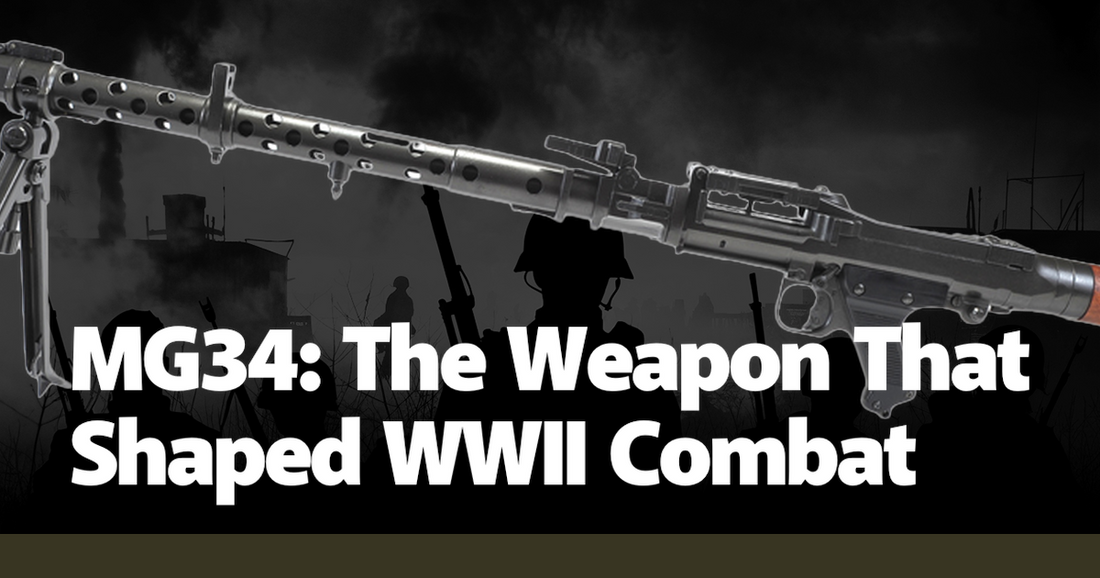The MG34, or Maschinengewehr 34, was more than just an infantry weapon; it was a revolutionary force that fundamentally altered the landscape of World War II combat. Introduced by Nazi Germany in 1934, the MG34 was the world’s first general-purpose machine gun, capable of providing both sustained fire as a heavy machine gun and rapid, portable fire as a light machine gun. This versatility made it an indispensable tool in the Wehrmacht's arsenal, allowing German forces to adapt quickly to various combat situations. Its design incorporated a recoil-operated firing mechanism, which enabled a rate of fire between 800 to 900 rounds per minute, setting a new standard for machine gun performance.
The MG34's impact was immediately felt during the early stages of the war. In the Blitzkrieg campaigns across Poland, France, and the Low Countries, the MG34's rapid-fire capability allowed German infantry to lay down suppressive fire with unprecedented efficiency. This machine gun could be mounted on a bipod for mobile use or on a tripod for more stable, sustained fire, making it a versatile tool in both offensive and defensive operations. For instance, during the invasion of France in 1940, MG34s were often used to establish defensive perimeters quickly, allowing German troops to hold key positions against counterattacks and enabling the rapid advance of armored units.
The MG34 was not without its flaws, however. Its precision engineering, while a testament to German manufacturing prowess, also made it prone to jamming in harsh conditions such as the muddy fields of Russia or the sandy deserts of North Africa. Despite these issues, the weapon's adaptability was showcased in various theaters of war. In North Africa, for example, the MG34 was often mounted on vehicles, transforming them into mobile fire platforms that could engage enemy forces at long range. This adaptability was crucial in the wide-open desert battles where mobility and firepower were key to survival.
One of the most compelling stories of the MG34 comes from the Eastern Front, where it became a symbol of both German efficiency and the brutal nature of the conflict. During the Battle of Stalingrad, the MG34 was used extensively in urban combat, where its high rate of fire could decimate Soviet infantry attempting to storm German-held buildings. The weapon's ability to switch between single-shot and fully automatic modes provided German soldiers with the flexibility to engage targets at varying distances, making it a formidable tool in the close-quarters battles that characterized the siege.
The MG34 also played a significant role in defensive operations, particularly in the later stages of the war as German forces found themselves increasingly on the back foot. In Normandy, during the D-Day landings, MG34s were entrenched in bunkers and pillboxes along the Atlantic Wall. Their high rate of fire and effective range posed a severe threat to Allied troops attempting to storm the beaches. Accounts from veterans often highlight the terrifying experience of facing these machine guns, describing how the rapid, relentless bursts of fire could cut down entire squads within seconds.
Despite its effectiveness, the MG34 was eventually overshadowed by its successor, the MG42, which was simpler to produce and even more reliable. However, the MG34 remained in service throughout the war due to its proven capabilities and the logistical challenges of replacing it entirely. The MG34's legacy continued post-war, influencing the design of future machine guns and being used by various military forces around the world. Its design principles can be seen in modern general-purpose machine guns, underscoring its lasting impact on military technology.
In retrospect, the MG34 was more than just a weapon; it was a paradigm shift in how machine guns were perceived and utilized in combat. Its introduction marked the beginning of a new era in warfare, where the versatility and adaptability of a single weapon could influence the outcome of battles and, by extension, the course of history. The MG34's story is a testament to the ingenuity and engineering prowess of its designers, as well as the brutal efficiency of the Wehrmacht's military strategy. It remains a symbol of the technological advancements and the devastating human costs of World War II.
The MG34's influence on World War II combat is a compelling study in the intersection of technology, strategy, and human experience. Its design and deployment reflect the broader themes of innovation and adaptation that characterized the conflict. As we look back on the history of this remarkable weapon, we are reminded of the profound ways in which technology can shape the course of human events, for better or worse. The MG34, with its blend of precision engineering and battlefield efficacy, stands as a powerful example of this dynamic, forever etched in the annals of military history.

